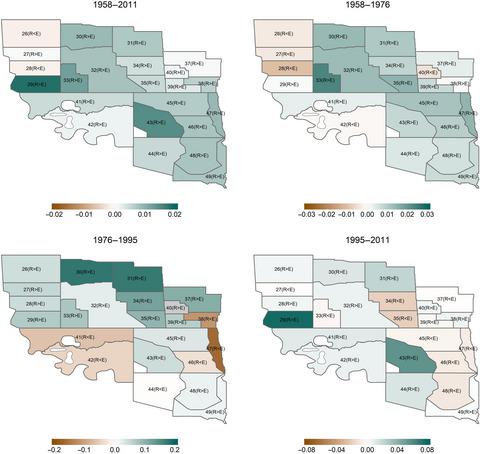当前位置:
X-MOL 学术
›
J. Anim. Ecol.
›
论文详情
Our official English website, www.x-mol.net, welcomes your feedback! (Note: you will need to create a separate account there.)
Changes in climate and land-use interact to create an ecological trap in a migratory species
Journal of Animal Ecology ( IF 4.8 ) Pub Date : 2020-04-30 , DOI: 10.1111/1365-2656.13228 Frances E Buderman 1 , Jim H Devries 2 , David N Koons 3
Journal of Animal Ecology ( IF 4.8 ) Pub Date : 2020-04-30 , DOI: 10.1111/1365-2656.13228 Frances E Buderman 1 , Jim H Devries 2 , David N Koons 3
Affiliation

|
Anthropogenic landscape alteration and climate change can have multi-scale and inter-related effects on ecological systems. Such changes to the environment can disrupt the connection between habitat quality and the cues that species use to identify quality habitat, which can result in an ecological trap. Ecological traps are typically difficult to identify without fine-scale information on individual survival and fitness, but this information is rarely available over large temporal and spatial scales. The Prairie Pothole Region (PPR) of the United States and Canada has undergone extensive changes in the latter half of the 20th century due to advancements in agricultural technologies, water management practices, and climate change. Historically, the PPR has been a highly productive area for breeding waterfowl. While the overall trends for dabbling ducks in the PPR have exhibited increasing abundances since the late 1980s, some species, such as the northern pintail, have been declining in abundance. We used a long-term data set of pintail counts across the PPR to separate count data into a demographic process and a habitat selection process using a hierarchical model. The hierarchical model provided an alternative way of identifying ecological traps in the absence of individual survival and fitness. Our model also allowed us to account for the indirect pathways by which climate and agriculture impact pintail through their additional contribution to wetland availability, which is a primary driver of pintail demography and habitat selection. Decoupling these processes allowed us to identify an ecological trap related to increasing cropland land cover, in which pintail selected for cropland over alternative nesting habitat, likely due to the similarities with productive native mixed-grass prairie. However, large proportions of cropland within a region resulted in fewer pintail the following year, likely due to nest failures from predation and agricultural practices. In addition, we identified several regions in Canada where this ecological trap is contributing significantly to mismatches between habitat selection and demographic processes.
中文翻译:

气候变化和土地利用相互作用,在迁徙物种中形成生态陷阱
人为景观改变和气候变化会对生态系统产生多尺度和相互关联的影响。环境的这种变化会破坏栖息地质量与物种用来识别优质栖息地的线索之间的联系,这可能导致生态陷阱。如果没有关于个体生存和适应度的精细信息,生态陷阱通常很难识别,但这些信息在大的时间和空间尺度上很少可用。由于农业技术、水资源管理实践和气候变化的进步,美国和加拿大的草原坑洼地区 (PPR) 在 20 世纪下半叶发生了广泛的变化。从历史上看,PPR 一直是繁殖水禽的高产区。虽然自 1980 年代后期以来,PPR 中涉水鸭的总体趋势显示出丰度增加,但某些物种(例如北针尾鸭)的丰度一直在下降。我们使用 PPR 中针尾计数的长期数据集,使用分层模型将计数数据分为人口统计过程和栖息地选择过程。层次模型提供了一种在缺乏个体生存和适应度的情况下识别生态陷阱的替代方法。我们的模型还使我们能够通过对湿地可用性的额外贡献来解释气候和农业影响针尾鱼的间接途径,这是针尾鱼人口统计学和栖息地选择的主要驱动因素。分离这些过程使我们能够确定与增加农田土地覆盖相关的生态陷阱,其中针尾草选择用于农田而不是替代筑巢栖息地,可能是由于与多产的本地混合草草原的相似性。然而,一个地区内大部分农田导致第二年的针尾减少,这可能是由于捕食和农业实践导致巢穴失败。此外,我们还确定了加拿大的几个地区,这些地区的生态陷阱对栖息地选择和人口过程之间的不匹配产生了重大影响。
更新日期:2020-04-30
中文翻译:

气候变化和土地利用相互作用,在迁徙物种中形成生态陷阱
人为景观改变和气候变化会对生态系统产生多尺度和相互关联的影响。环境的这种变化会破坏栖息地质量与物种用来识别优质栖息地的线索之间的联系,这可能导致生态陷阱。如果没有关于个体生存和适应度的精细信息,生态陷阱通常很难识别,但这些信息在大的时间和空间尺度上很少可用。由于农业技术、水资源管理实践和气候变化的进步,美国和加拿大的草原坑洼地区 (PPR) 在 20 世纪下半叶发生了广泛的变化。从历史上看,PPR 一直是繁殖水禽的高产区。虽然自 1980 年代后期以来,PPR 中涉水鸭的总体趋势显示出丰度增加,但某些物种(例如北针尾鸭)的丰度一直在下降。我们使用 PPR 中针尾计数的长期数据集,使用分层模型将计数数据分为人口统计过程和栖息地选择过程。层次模型提供了一种在缺乏个体生存和适应度的情况下识别生态陷阱的替代方法。我们的模型还使我们能够通过对湿地可用性的额外贡献来解释气候和农业影响针尾鱼的间接途径,这是针尾鱼人口统计学和栖息地选择的主要驱动因素。分离这些过程使我们能够确定与增加农田土地覆盖相关的生态陷阱,其中针尾草选择用于农田而不是替代筑巢栖息地,可能是由于与多产的本地混合草草原的相似性。然而,一个地区内大部分农田导致第二年的针尾减少,这可能是由于捕食和农业实践导致巢穴失败。此外,我们还确定了加拿大的几个地区,这些地区的生态陷阱对栖息地选择和人口过程之间的不匹配产生了重大影响。



























 京公网安备 11010802027423号
京公网安备 11010802027423号